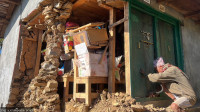Sun, Dec 21, 2025
Opinion
Avoiding turbulence
Debates on Nijgadh airport should move beyond binaries
bookmark
Atindra Dahal
Published at : December 26, 2018
Updated at : December 26, 2018 08:51
Since it was first announced, the proposed Nijgadh airport has sprouted national moot among politicians to civilians. Debates on recent efforts to enhance tourism—many of which perpetuate a false ‘environment versus development binary—are swiftly swelling the country. Cutting through the misguided logic in most of these debates, it is important to recognise the profound significance of the airport. Constructing the airport immediately with minimal environmental consequences and the earliest compensation seems to be a modestly rational vision for the socio-economic transformation of Nepal. This airport is one of vital importance and cannot be delayed for reasons whatsoever.
Tribhuvan International Airport, currently our only international standard airport, is relatively small, has only one runway and undergoes repeatedly hectic air traffic (of 10 minutes in average). Hence, the government’s 1995 pre-feasibility survey of potential locations for an additional airport marked Nijgadh as the best viable place among eight other options. As per the reports, plans for the new airport will occupy 2,556 hectares of land, it will have two runways, six boarding gates, 34 check-in points, six security posts, 35 immigration stations, and eight custom sections. It estimates that once it reaches optimum scale of construction and operation, it will annually serve 60 million passengers.
While several argue that the airport is ‘unnecessarily large,’ it is important to draw comparisons with other international airports. Currently, King Fahd International Airport (77,600 hectares) is the largest in area followed by Denver International Airport (13571 hectares) and Dallas International Airport (6953 hectares). Turkey recently announced plans to construct a new airport (7650 hectares) and has fell over 600,000 trees for it. In the case of Nepal, we are debating to cut down only approximately 200,000.
Every development project has some environment impact; development with zero damage is tantamount to utopia. As highlighted in Joan Maloof and Robert Llewellyn’s book The Living Forest, globally, the Christmas tree industry leads to the cutting of over 40 million trees and pencil industries do the same for 8 million. If the government cuts 200,000 trees for the airport, it can easily engage in a tree planting campaign around the area to plant more than what was cut. Rather than merely sticking on the puritanical polemic of ‘preserve the forest or bust,’ current debates should find compromises that recognise the importance of both the airport and the environment.
Nepal’s geography provides ample challenges to find suitable locations for an airport of this size. The proposed land is perfectly suited for the project and will make for a safer runaway. Searching for another viable place for the airport will truly be a waste of time. The hilly and mountainous regions of Nepal provide no options because of their rough, incongruent and inadequate topography. Furthermore, rather than projecting the construction of the airport as an ‘enemy to the environment,’ steps could be taken to promote environmentalism following its completion. Timber (about 2 lakh cubic metres) procured from cutting the trees can bear 30 percent of the construction expenses, for example.
Globally, the number of air passengers is rising at rapid rates. The International Air Transport Association recently forecasted that about 7.2 billion people will turn to air-travel by 2035 and 65 percent of them will be of Asian nationalities. Recognising this growing demand in the market, many countries have invested in the construction of new airports. China reportedly constructed 30 new airports this year and India aims to add 100 more by the next 25 years. Nepal received one million tourists in the last ten months and is planning to welcome two million in 2020. The current International airport—which struggled to serve 1.9 million passengers in 2008—has barely managed to serve 5.3 million in 2016.
This year, we marked the end of political transition and the onset of economic prosperity. Progress on large-scale projects including the Melamchi project, Upper Tamakoshi hydro, KathamnduTerai fast-track and Nijgadh airport can set exemplary steps forward in this regard.As construction takes a decade, we have plenty of time to find more compromises between environmentalism and development. The situation isn’t binary.
Dahal is an associate professor at the Kathmandu School of Law.
Editor's Picks
E-PAPER | December 21, 2025
×




 19.12°C Kathmandu
19.12°C Kathmandu










